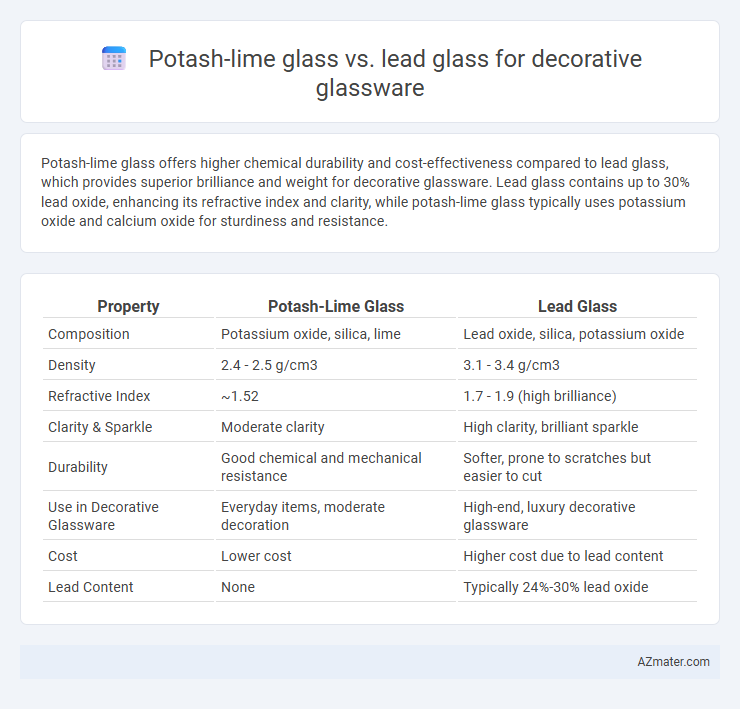Potash-lime glass offers higher chemical durability and cost-effectiveness compared to lead glass, which provides superior brilliance and weight for decorative glassware. Lead glass contains up to 30% lead oxide, enhancing its refractive index and clarity, while potash-lime glass typically uses potassium oxide and calcium oxide for sturdiness and resistance.
Table of Comparison
| Property | Potash-Lime Glass | Lead Glass |
|---|---|---|
| Composition | Potassium oxide, silica, lime | Lead oxide, silica, potassium oxide |
| Density | 2.4 - 2.5 g/cm3 | 3.1 - 3.4 g/cm3 |
| Refractive Index | ~1.52 | 1.7 - 1.9 (high brilliance) |
| Clarity & Sparkle | Moderate clarity | High clarity, brilliant sparkle |
| Durability | Good chemical and mechanical resistance | Softer, prone to scratches but easier to cut |
| Use in Decorative Glassware | Everyday items, moderate decoration | High-end, luxury decorative glassware |
| Cost | Lower cost | Higher cost due to lead content |
| Lead Content | None | Typically 24%-30% lead oxide |
Introduction to Decorative Glassware Materials
Potash-lime glass and lead glass are two primary materials used in decorative glassware production, each offering distinct properties that influence design and functionality. Potash-lime glass, composed mainly of silica, potash, and lime, is valued for its durability, chemical stability, and resistance to weathering, making it ideal for everyday decorative items. Lead glass contains high levels of lead oxide, which increases its density and refractive index, providing exceptional brilliance and clarity favored in fine crystalware and luxury decorative pieces.
Overview of Potash-Lime Glass
Potash-lime glass is a common type of soda-lime glass that substitutes potash (potassium oxide) for soda (sodium oxide), enhancing its chemical durability and lowering melting points compared to standard soda-lime glass. It offers moderate refractive index and clarity, making it suitable for decorative glassware that requires durability without the weight or cost of lead glass. Potash-lime glass exhibits improved resistance to water and alkalis, making it ideal for functional decorative items with a balance of aesthetic appeal and practical performance.
Key Characteristics of Lead Glass
Lead glass, also known as lead crystal, is distinguished by its high refractive index and exceptional brilliance, making it highly prized for decorative glassware. Its composition typically includes 24-30% lead oxide, which enhances clarity, weight, and workability, allowing intricate designs and a smooth finish. Compared to potash-lime glass, lead glass offers superior optical properties and a distinctive resonance when tapped, contributing to its luxurious aesthetic appeal.
Visual Differences: Clarity and Brilliance
Potash-lime glass exhibits moderate clarity with a slight greenish tint due to its iron content, resulting in less brilliance compared to lead glass. Lead glass, containing 24-30% lead oxide, offers superior clarity and exceptional brilliance by enhancing light refraction and sparkle, making it ideal for high-end decorative glassware. The higher refractive index of lead glass, typically around 1.7, significantly surpasses that of potash-lime glass (approximately 1.5), contributing to its radiant and luxurious appearance.
Durability and Strength Comparison
Potash-lime glass exhibits higher chemical durability and better resistance to weathering compared to lead glass, making it more suitable for long-lasting decorative glassware exposed to environmental stress. Lead glass, while prized for its optical clarity and weight, is softer and more prone to scratches and chips, reducing its strength and durability in practical use. The higher refractive index of lead glass enhances brilliance but compromises mechanical robustness relative to the tougher, alkali-rich composition of potash-lime glass.
Workability for Artisans and Designers
Potash-lime glass offers superior workability for artisans and designers due to its lower melting temperature and greater malleability, making it ideal for intricate decorative glassware. Lead glass, while prized for its brilliance and clarity, poses challenges in shaping because of its higher density and viscosity, which can limit detailed craftsmanship. The ease of reheating and shaping potash-lime glass results in more efficient manipulation, enabling more complex and delicate artistic designs.
Safety and Health Considerations
Potash-lime glass, containing primarily potassium oxide and lime, is generally safer for decorative glassware due to its low toxicity and lack of heavy metals. Lead glass, containing significant amounts of lead oxide, poses health risks such as lead leaching, which can cause poisoning especially if used for food or drink containers. Choosing potash-lime glass reduces exposure to harmful substances, making it a safer option for both artisans and consumers concerned with health and environmental impact.
Common Uses in Decorative Glassware
Potash-lime glass is widely used in decorative glassware for its durability and ease of coloring, making it ideal for intricate designs and everyday ornamental items like vases and bowls. Lead glass, known for its high refractive index and brilliance, is preferred in luxury decorative pieces such as crystal chandeliers, fine stemware, and intricate figurines. Both types enhance aesthetic appeal, with potash-lime glass favored for functional decor and lead glass prized for its elegance and light-reflecting qualities.
Cost and Market Availability
Potash-lime glass is generally more cost-effective and widely available in the decorative glassware market, making it a preferred choice for mass-produced items. Lead glass, while more expensive due to its higher lead oxide content and enhanced refractive qualities, appeals to niche markets seeking luxury and brilliance. Both types have distinct market segments, with potash-lime glass dominating in affordability and accessibility, and lead glass valued for its premium aesthetic properties.
Choosing the Right Glass for Decorative Projects
Potash-lime glass, known for its durability and cost-effectiveness, is ideal for decorative glassware requiring strength and everyday use, while lead glass offers superior brilliance and clarity, making it suitable for high-end, intricate designs. Potash-lime glass contains potassium oxide and calcium oxide, enhancing chemical resistance and thermal stability, whereas lead glass incorporates lead oxide, increasing refractive index and weight for sparkling visual effects. Selecting the right glass depends on balancing durability, optical properties, and project budget to achieve desired aesthetic and functional outcomes.

Infographic: Potash-lime glass vs Lead glass for Decorative glassware
 azmater.com
azmater.com